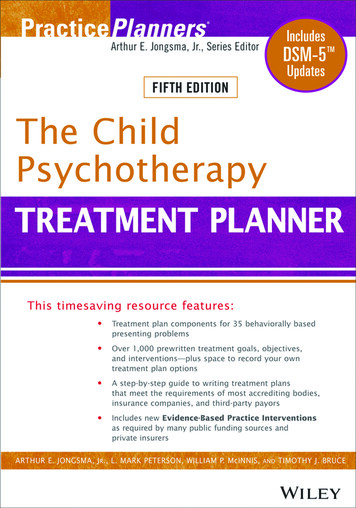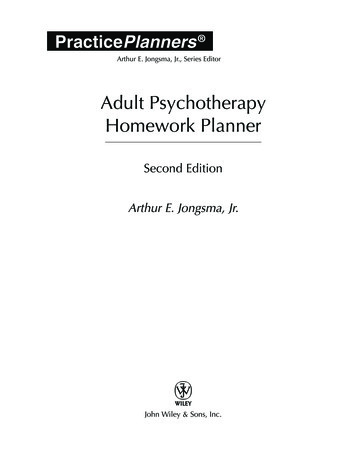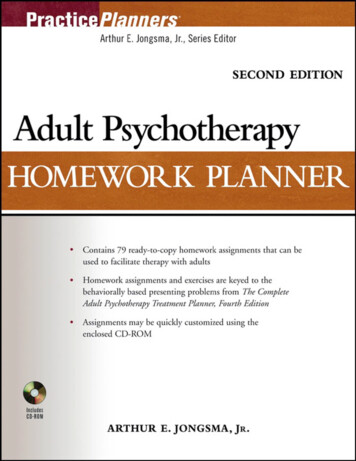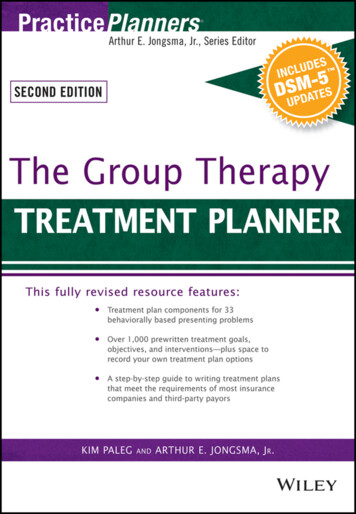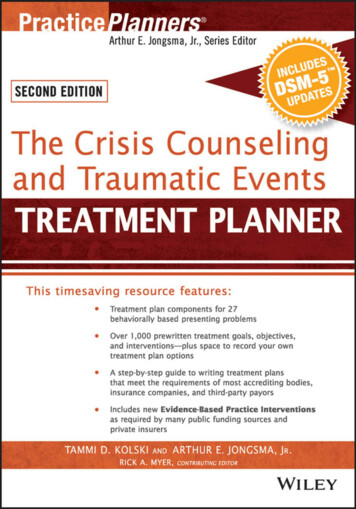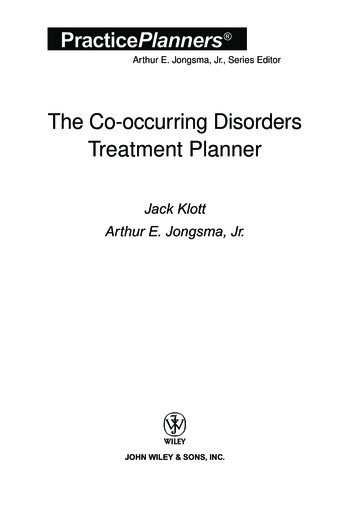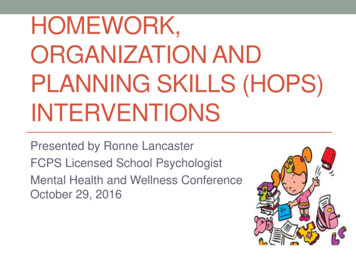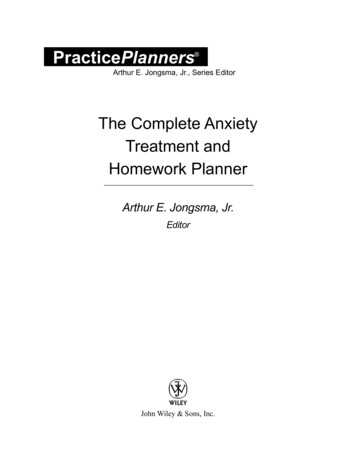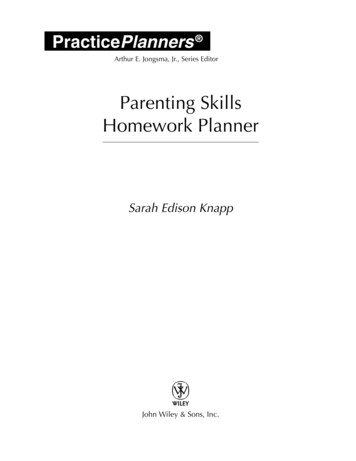
Transcription
Child PsychotherapyHomework PlannerFifth Edition
PracticePlanners SeriesTreatment PlannersThe Complete Adult Psychotherapy Treatment Planner, Fifth EditionThe Child Psychotherapy Treatment Planner, Fifth EditionThe Adolescent Psychotherapy Treatment Planner, Fifth EditionThe Addiction Treatment Planner, Fifth EditionThe Continuum of Care Treatment PlannerThe Couples Psychotherapy Treatment Planner, Second EditionThe Employee Assistance Treatment PlannerThe Pastoral Counseling Treatment PlannerThe Older Adult Psychotherapy Treatment Planner, Second EditionThe Behavioral Medicine Treatment PlannerThe Group Therapy Treatment PlannerThe Gay and Lesbian Psychotherapy Treatment PlannerThe Family Therapy Treatment Planner, Second EditionThe Severe and Persistent Mental Illness Treatment Planner, Second EditionThe Mental Retardation and Developmental Disability Treatment PlannerThe Social Work and Human Services Treatment PlannerThe Crisis Counseling and Traumatic Events Treatment Planner, Second EditionThe Personality Disorders Treatments PlannerThe Rehabilitation Psychology Treatment PlannerThe Special Education Treatment plannerThe Juvenile Justice and Residential Care Treatment PlannerThe School Counseling and School Social Work Treatment Planner, Second EditionThe Sexual Abuse Victim and Sexual Offender Treatment PlannerThe Probation and Parole Treatment PlannerThe Psychopharmacology Treatment PlannerThe Speech-Language Pathology Treatment PlannerThe Suicide and Homicide Treatment PlannerThe College Student Counseling Treatment PlannerThe Parenting Skills Treatment PlannerThe Early Childhood Intervention Treatment PlannerThe Co-Occurring Disorders Treatment PlannerThe Complete Women’s Psychotherapy Treatment PlannerThe Veterans and Active Duty Military Psychotherapy Treatment PlannerProgress Notes PlannersThe Child Psychotherapy Progress Notes Planner, Fifth EditionThe Adolescent Psychotherapy Progress Notes Planner, Fifth EditionThe Adult Psychotherapy Progress Notes Planner, Fifth EditionThe Addiction Progress Notes Planner, Fifth EditionThe Severe and Persistent Mental Illness Progress Notes Planner, Second EditionThe Couples Psychotherapy Progress Notes Planner, Second EditionThe Family Therapy Progress Notes Planner, Second EditionThe Veterans and Active Duty Military Psychotherapy Progress Notes PlannerHomework PlannersCouples Therapy Homework Planner, Second EditionFamily Therapy Homework Planner, Second EditionGrief Counseling Homework PlannerGroup Therapy Homework PlannerDivorce Counseling Homework PlannerSchool Counseling and School Social Work Homework Planner, Second EditionChild Therapy Activity and Homework PlannerAddiction Treatment Homework Planner, Fifth EditionAdolescent Psychotherapy Homework Planner, Fifth EditionAdult Psychotherapy Homework Planner, Fifth EditionChild Psychotherapy Homework Planner, Fifth EditionParenting Skills Homework PlannerVeterans and Active Duty Military Psychotherapy Homework PlannerClient Education Handout PlannersAdult Client Education Handout PlannerChild and Adolescent Client Education Handout PlannerCouples and Family Client Education Handout PlannerComplete PlannersThe Complete Depression Treatment and Homework PlannerThe Complete Anxiety Treatment and Homework Planner
PracticePlanners Child PsychotherapyHomework PlannerFifth EditionArthur E. Jongsma, Jr.L. Mark PetersonWilliam P. McInnis
Cover image: Ryan McVay/Getty ImagesCover design: WileyThis book is printed on acid-free paper.Copyright 2014 by Arthur E. Jongsma, Jr., L. Mark Peterson, and William P. McInnis. All rights reserved.Published by John Wiley & Sons, Inc., Hoboken, New JerseyPublished simultaneously in CanadaNo part of this publication may be reproduced, stored in a retrieval system, or transmitted in any form or byany means, electronic, mechanical, photocopying, recording, scanning, or otherwise, except as permitted underSection 107 or 108 of the 1976 United States Copyright Act, without either the prior written permission of thePublisher, or authorization through payment of the appropriate per-copy fee to the Copyright Clearance Center,222 Rosewood Drive, Danvers, MA 01923, (978) 750-8400, fax (978) 646-8600, or on the web atwww.copyright.com. Requests to the Publisher for permission should be addressed to the PermissionsDepartment, John Wiley & Sons, Inc., 111 River Street, Hoboken, NJ 07030, (201) 748-6011, fax (201) 748-6008,or online at www.wiley.com/go/permissions.Limit of Liability/Disclaimer of Warranty: While the publisher and author have used their best efforts inpreparing this book, they make no representations or warranties with the respect to the accuracy orcompleteness of the contents of this book and specifically disclaim any implied warranties of merchantability orfitness for a particular purpose. No warranty may be created or extended by sales representatives or writtensales materials. The advice and strategies contained herein may not be suitable for your situation. You shouldconsult with a professional where appropriate. Neither the publisher nor the author shall be liable for damagesarising here from.For general information about our other products and services, please contact our Customer Care Departmentwithin the United States at (800) 762-2974, outside the United States at (317) 572-3993 or fax (317) 572-4002.Wiley publishes in a variety of print and electronic formats and by print-on-demand. Some material includedwith standard print versions of this book may not be included in e-books or in print-on-demand. If this bookrefers to media such as a CD or DVD that is not included in the version you purchased, you may download thismaterial at http://booksupport.wiley.com. For more information about Wiley products, visit www.wiley.com.ISBN 978-1-118-07674-3 (paper)ISBN 978-1-118-41597-9 (ebk.)ISBN 978-1-118-41885-7 (ebk.)Printed in the United States of America10 9 8 7 6 5 4 3 2 1
This book is dedicated to our fathers and fathers-in-law:William “Muggs” McInnisRobert WieringaArthur E. Jongsma, Sr.Frank LandisLloyd PetersonJames ShanksThey have blessed us in so many ways throughtheir love, laughter, guidance, and support.
CONTENTSPracticePlanners Series PrefaceAcknowledgmentsIntroductionxvxvii1SECTION 1—Academic Underachievement4Exercise 1.AEstablish a Homework Routine5Exercise 1.BPositive Self-Statements9Exercise 1.CReading AdventureSECTION 2—Adoption1114Exercise 2.AQuestions and Concerns About Being Adopted15Exercise 2.BSome Things I Would Like You to Know About Me17SECTION 3—Anger Control Problems20Exercise 3.AAnger Control21Exercise 3.BChild Anger Checklist29Exercise 3.CThe Lesson of Salmon Rock . . . Fighting Leads to Loneliness32SECTION 4—Anxiety37Exercise 4.AAn Anxious Story38Exercise 4.BDeep Breathing Exercise41Exercise 4.CFinding and Losing Your Anxiety44Exercise 4.DWorry Time48SECTION 5—Attachment Disorder50Exercise 5.AAttachment Survey51Exercise 5.BBuilding Relationships54SECTION 6—Attention-Deficit/Hyperactivity Disorder (ADHD)56Exercise 6.AGetting It Done57Exercise 6.BProblem-Solving Exercise62Exercise 6.CSocial Skills Exercise66ix
xCONTENTSSECTION 7—Autism Spectrum Disorder69Exercise 7.AInitial Reaction to Diagnosis of Autism70Exercise 7.BReaction to Change and Excessive Stimulation73SECTION 8—Blended Family76Exercise 8.ABlended Family Sentence Completion77Exercise 8.BInterviewing My New Family Member81Exercise 8.CThoughts and Feelings About Parent’s Live-In Partner85SECTION 9—Bullying/Intimidation Perpetrator88Exercise 9.AApology Letter for Bullying89Exercise 9.BBullying Incident Report92SECTION 10—Conduct Disorder/Delinquency94Exercise 10.ABuilding EmpathyExercise 10.BChildhood Patterns of Stealing100Exercise 10.CConcerns About Parent’s Drug or Alcohol Problem104Exercise 10.DRisk Factors Leading to Child Behavior Problems108SECTION 11—Depression95110Exercise 11.AChildhood Depression Survey111Exercise 11.BReplace Negative Thoughts With Positive Self-Talk114Exercise 11.CSurface Behavior/Inner Feelings116Exercise 11.DThree Ways to Change the World120SECTION 12—Disruptive/Attention-Seeking122Exercise 12.AFinding Ways to Get Positive Attention123Exercise 12.BReasons for Negative Attention-Seeking Behaviors127SECTION 13—Divorce Reaction130Exercise 13.AFeelings and Faces Game131Exercise 13.BMy Thoughts and Feelings About My Parents’ Divorce135SECTION 14—Enuresis/Encopresis137Exercise 14.ABladder Retention Training Program138Exercise 14.BBowel Control Training Program142Exercise 14.CDry Bed Training Program149
CONTENTSSECTION 15—Fire Settingxi152Exercise 15.AFireproofing Your Home and Family153Exercise 15.BWhen a Fire Has No Fuel156SECTION 16—Gender Identity Disorder158Exercise 16.AI Want to Be Like . . .159Exercise 16.BOne-on-One162SECTION 17—Grief/Loss Unresolved164Exercise 17.ACreate a Memory Album165Exercise 17.BGrief Letter167Exercise 17.CPetey’s Journey Through Sadness171SECTION 18—Intellectual Development Disorder177Exercise 18.AActivities of Daily Living Program178Exercise 18.BA Sense of Belonging183SECTION 19—Low Self-Esteem186Exercise 19.ADixie Overcomes Her Fears187Exercise 19.BLearn From Your Mistakes194Exercise 19.CSymbols of Self-Worth197Exercise 19.DThree Ways to Change Yourself200Exercise 19.EThree Wishes Game203SECTION 20—Lying/Manipulative204Exercise 20.ABad Choice—Lying to Cover Up Another Lie205Exercise 20.BThe Value of Honesty209Exercise 20.CTruthful/Lying Incident Reports215SECTION 21—Medical Condition217Exercise 21.ADealing with Childhood Asthma218Exercise 21.BGaining Acceptance of Physical Handicap or Illness223SECTION 22—Obsessive-Compulsive Disorder (OCD)226Exercise 22.AConcerns, Feelings, and Hopes About OCD227Exercise 22.BRefocusing230Exercise 22.CRitual Exposure and Response Prevention233
xiiCONTENTSSECTION 23—Oppositional Defiant237Exercise 23.AFiling a Complaint238Exercise 23.BIf I Could Run My Family241Exercise 23.CShare a Family Meal245Exercise 23.DSwitching From Defense to Offense251SECTION 24—Overweight/Obesity254Exercise 24.ADeveloping and Implementing a Healthier Diet255Exercise 24.BIncreasing My Physical Activity260Exercise 24.CMy Eating and Exercise Journal264SECTION 25—Parenting267Exercise 25.ABeing a Consistent Parent268Exercise 25.BPicking Your Battles272SECTION 26—Peer/Sibling Conflict274Exercise 26.AJoseph, His “Amazing Technicolor Coat,” and More275Exercise 26.BNegotiating a Peace Treaty279SECTION 27—Physical/Emotional Abuse Victim281Exercise 27.ALetter of Empowerment282Exercise 27.BMy Thoughts and Feelings286SECTION 28—Posttraumatic Stress Disorder (PTSD)288Exercise 28.AFinding My Triggers289Exercise 28.BPTSD Incident Report293SECTION 29—School Refusal295Exercise 29.AA Pleasant Journey296Exercise 29.BLetter of Encouragement299Exercise 29.CSchool Fear Reduction302SECTION 30—Separation Anxiety305Exercise 30.AExplore Your World306Exercise 30.BParents’ Time Away309
CONTENTSSECTION 31—Sexual Abuse Victimxiii311Exercise 31.AMy Story312Exercise 31.BYou Are Not Alone315SECTION 32—Sleep Disturbance319Exercise 32.AChildhood Sleep Problems320Exercise 32.BReduce Nighttime Fears324SECTION 33—Social Anxiety327Exercise 33.AGreeting Peers328Exercise 33.BLearn to Be Assertive331Exercise 33.CShow Your Strengths337SECTION 34—Specific Phobia339Exercise 34.AExpressions of Fear Through Art340Exercise 34.BMaurice Faces His Fear343SECTION 35—Speech/Language Disorders348Exercise 35.AHome-Based Reading and Language Program349Exercise 35.BShauna’s Song354Exercise 35.CTell All About It362Appendix A: Alternate Assignments for Presenting Problems364Appendix B: Alphabetical Index of Exercises377About the CD-ROM380Downloadable CD material at http://booksupport.wiley.com380
PRACTICEPLANNERS SERIES PREFACEAccountability is an important dimension of the practice of psychotherapy. Treatmentprograms, public agencies, clinics, and practitioners must justify and document theirtreatment plans to outside review entities in order to be reimbursed for services. Thebooks and software in the PracticePlanners series are designed to help practitionersfulfill these documentation requirements efficiently and professionally.The PracticePlanners series includes a wide array of treatment planning booksincluding not only the original Complete Adult Psychotherapy Treatment Planner, ChildPsychotherapy Treatment Planner, and Adolescent Psychotherapy Treatment Planner,all now in their fifth editions, but also Treatment Planners targeted to specialty areas ofpractice, including: AddictionsCo-occurring disordersBehavioral medicineCollege studentsCouples therapyCrisis counselingEarly childhood educationEmployee assistanceFamily therapyGays and lesbiansGroup therapyJuvenile justice and residential careMental retardation and developmental disabilityNeuropsychologyOlder adultsParenting skillsPastoral counselingPersonality disordersProbation and parolePsychopharmacologyRehabilitation psychologySchool counseling and school social workSevere and persistent mental illnessSexual abuse victims and offendersxv
xviPRACTICEPLANNERS SERIES PREFACE Social work and human servicesSpecial educationSpeech-language pathologySuicide and homicide risk assessmentVeterans and active military dutyWomen’s issuesIn addition, there are three branches of companion books that can be used inconjunction with the Treatment Planners, or on their own: Progress Notes Planners provide a menu of progress statements that elaborateon the client’s symptom presentation and the provider’s therapeutic intervention.Each Progress Notes Planner statement is directly integrated with the behavioraldefinitions and therapeutic interventions from its companion Treatment Planner. Homework Planners include homework assignments designed around eachpresenting problem (such as anxiety, depression, substance use, anger controlproblems, eating disorders, or panic disorder) that is the focus of a chapter in itscorresponding Treatment Planner. Client Education Handout Planners provide brochures and handouts to helpeducate and inform clients on presenting problems and mental health issues, aswell as life skills techniques. The handouts are included on CD-ROMs for easyprinting from your computer and are ideal for use in waiting rooms, atpresentations, as newsletters, or as information for clients struggling with mentalillness issues. The topics covered by these handouts correspond to the presentingproblems in the Treatment Planners.Adjunctive books, such as The Psychotherapy Documentation Primer and The ClinicalDocumentation Sourcebook, contain forms and resources to aid the clinician in mentalhealth practice management.The goal of our series is to provide practitioners with the resources they need inorder to provide high quality care in the era of accountability. To put it simply: We seekto help you spend more time on patients, and less time on paperwork.ARTHUR E. JONGSMA, JR.Grand Rapids, Michigan
ACKNOWLEDGMENTSWe want to acknowledge and express appreciation to our wives—Judy, Cherry, andLynn—who have supported us through the many years of the PracticePlanners series.We appreciate their willingness to read the manuscripts and offer helpful suggestions.And, speaking of manuscript preparation, this project has had the benefit of manyhours of perseverance by our dedicated typist, Sue Rhoda. She has organized ourchaotic, scribbled details into a meaningful manuscript with a spirit of kindness andgenerosity. Thank you, Sue, for your loyalty and good work. Additionally, we would liketo thank Blake Jurgens for his help with the artwork on the “Feelings and Faces”assignment.A. E. J.L. M. P.W. P. M.xvii
Child PsychotherapyHomework PlannerFifth Edition
INTRODUCTIONMore and more therapists are assigning homework to their clients. Not only have shortterm therapy models endorsed this practice, but the benefits are being recognized bymany traditional therapists as well.WHY HOMEWORK?Assigning homework to psychotherapy clients is beneficial for several reasons. With theadvent of managed care, which often requires shorter and fewer treatment sessions,therapists assign between-session homework to help maximize the effectiveness ofbriefer treatment. Homework is an extension of the treatment process, providescontinuity, and allows the client to work between sessions on issues that are the focusof therapy. Homework can also be a tool for more fully engaging the client in thetreatment process. Assignments place more responsibility on the client to resolve his orher presenting problems, counteracting the expectations that some clients mayexperience that it is the therapist alone who can cure him or her. For some, it even maybring a sense of self-empowerment.Another added benefit of homework is that these assignments give the client theopportunity to implement and evaluate insights or coping behaviors that have beendiscussed in therapy sessions. Practice often heightens awareness of various issues.Furthermore, homework increases the expectation for the client to follow through withmaking changes rather than just talking about change. Exercises require participation,which creates a sense that the client is taking active steps toward change. Homeworkalso allows the client to try new behaviors, bringing these experiences back to the nextsession for processing. Modifications can then be made to the client’s thoughts, feelings,or behaviors as the homework is processed in the therapy session.Occasionally treatment processes can become vague and abstract. By adding focusand structure, homework assignments can reenergize treatment. Moreover, homeworkcan increase the client’s motivation to change as it provides something specific to workon. Additionally, homework increases the involvement of family members andsignificant others in the client’s treatment using assignments that call for theirparticipation. Homework promotes more efficient treatment by encouraging the clientto actively develop insights, positive self-talk, and coping behaviors between therapysessions. Consequently, many clients express increased satisfaction with the treatmentprocess when homework is given. They are empowered by doing something active thatfacilitates the change process, and it reinforces their sense of control over the problem.These advantages have made the assignment of therapeutic homework increasinglyprevalent.INTRODUCTION 1
HOW TO USE THIS HOMEWORK PLANNERCreating homework assignments and developing the printed forms for recordingresponses is a time-consuming process. This Child Psychotherapy Homework Plannerprovides a menu of homework assignments that can easily be photocopied. In additionto the printed format, the assignments in this Planner are provided on a CD-ROM toallow the therapist to access them on a word processor and print them out as is oreasily custom-tailor them to suit the client’s individual needs and/or the therapist’sstyle.The assignments are grouped under presenting problems that are typical of thosefound in a child population. These presenting problems are cross-referenced to everypresenting problem found in The Child Psychotherapy Treatment Planner, fifth edition.Although these assignments were created with a specific presenting problem in mind,don’t feel locked in by a single problem-oriented chapter when searching for anappropriate assignment. Included with each exercise is a cross-referenced list ofsuggested presenting problems for which the assignment may be appropriate anduseful called “Additional Problems for Which This Exercise May Be Most Useful.” Thiscross-referenced list can assist you in applying the homework assignments to othersituations that may be relevant to your client’s particular presenting problem.A broader cross-referenced list of assignments is found in the Appendix “AlternateAssignments for Presenting Problems.” Review this Appendix to find relevantassignments beyond the two or three exercises found in any specific presenting problemchapter. For example, under the heading of Conduct Disorder/Delinquency in theAppendix, you will find 18 alternative assignments originally created for otherpresenting problems but relevant and easily adapted for use with a client strugglingwith conduct disorder issues. In this Appendix, every presenting problem is listed withrelevant additional assignments from throughout the book. Remember, eachassignment is available on the companion CD-ROM and, therefore, can be quicklyedited for use with a specific client. This modified assignment can be saved on yourcomputer’s hard disk for repeated later use.This newest edition of the Child Psychotherapy Homework Planner includes someimportant changes. A number of the homework assignments from the previous editionof the Child Psychotherapy Homework Planner have been shortened and/or modified tomake them more user-friendly for the child. A few of the old homework assignmentswere omitted, but several new assignments have been added. The improvements in theChild Psychotherapy Homework Planner, fifth edition, make it a valuable therapeutictool/resource for the practicing clinician.ABOUT THE ASSIGNMENTSSome of the assignments are designed for the parents of a child who is in treatment;others are for the client; still others are designed for the parents and child to completetogether. Therapists introduce the homework assignment with varying degrees of detailand client preparation. Recommendations regarding this preparation and post-exercisediscussion are made on the title page of each assignment under the heading“Suggestions for Processing This Exercise With the Client.”2 INTRODUCTION
Clinical judgment must be used to assess the appropriate developmental levelnecessary for a specific assignment, as well as choosing the homework assignmentsthat focus on relevant issues for the client. The title page of each assignment contains asection on “Goals of the Exercise” to guide you in your selection of relevant homeworkfor your client. Remember, all assignments can be modified as necessary for theindividual client.CARRYING OUT THE ASSIGNMENTIt is recommended that you review the entire book to familiarize yourself with thebroad nature of the type and focus of the various homework exercises. Select a specificassignment from a chapter titled with your client’s presenting problem or from thealternative list in the Appendix and then review the list of homework goals. Assigningtherapy homework is just a beginning step in the therapy treatment process. Carryingout the assignment requires a follow-up exploration of the impact of the assignment onthe client’s thoughts, feelings, and behavior. What are the results? Was this assignmentuseful to the client? Can it be redesigned or altered for better results? Examine andsearch for new and creative ways to actively engage your client in participating in thishomework process.ARTHUR E. JONGSMA, JR.L. MARK PETERSONWILLIAM P. MCINNISINTRODUCTION 3
SECTION 1: ACADEMIC UNDERACHIEVEMENTTherapist’s OverviewESTABLISH A HOMEWORK ROUTINEGOALS OF THE EXERCISE1.2.3.Assess the client’s mood and attitude surrounding the completion of his/herhomework.Establish general guidelines and/or a routine to help the client complete his/herhomework.Complete school and homework assignments on a regular and consistent basis.ADDITIONAL PROBLEMS FOR WHICH THIS EXERCISE MAY BE MOST USEFUL Attention-Deficit/Hyperactivity Disorder (ADHD)Oppositional DefiantSUGGESTIONS FOR PROCESSING THIS EXERCISE WITH THE CLIENTThis assignment is given to the parents of the client who has trouble completing his/herhomework in a regular or consistent manner. The parents’ responses to the variousquestions will hopefully help the therapist gain greater insight into the factorscontributing to the client’s failure or resistance to regularly complete his/her homework.The parents are asked to identify the client’s mood or attitude surrounding homework.After responding to several questions, the parents are also asked to list three to fiveguidelines, rules, or interventions that they can implement to help the child completehis/her homework. The therapist should review the parents’ responses in a follow-uptherapy session and then help the client and parents develop a regular routine forcompleting the homework.4ACADEMIC UNDERACHIEVEMENT
EXERCISE 1.AESTABLISH A HOMEWORK ROUTINEEducators and therapists have found that providing structure and a routine for a childcan help him/her complete his/her homework on a regular basis. Having a routine canalso cut down on the number of arguments between the parents and the child. In thisexercise, you are asked to answer several questions that will help your therapistunderstand your child’s moods or attitudes about completing his/her homework. Youranswers will hopefully also identify some of the problems that have contributed to yourchild’s difficulty with completing his/her homework. The ultimate goal of thisassignment is to establish a routine that will help your child regularly complete his/herhomework in a timely manner.1. On the average, how much time does your child spend on homework each night?none30 minutes to 1 hour1 to 15 minutes1 to 2 hours15 to 30 minutesover 2 hours2. What is your child’s usual mood or attitude when completing his/her homework?Please review the following list and check all that apply.Good attitude—willing to do homework without complainingIndifferent or “I don’t care” attitudeBored and/or distractedMakes up lies about not having homeworkOften tries to avoid or procrastinate doing homeworkComplains at first, but then settles down to do homeworkNegative attitude—frequent complaints and expressions of anger abouthaving to do homeworkFrequent yelling, screaming, or crying when required to do homeworkNervous or unsure of self when doing homeworkGives up easily when encountering frustrating or difficult tasksSad and disappointed in selfExpects to fail or do poorlyOtherACADEMIC UNDERACHIEVEMENT5
EXERCISE 1.A3. If your child has developed a negative attitude about his/her homework, whatfactors or stressors have contributed to your child’s negative attitude?4. What is usually the best time of the day for your child to complete his/herhomework?Immediately after getting homefrom schoolAllow child time to have snack,play, or watch TV for 30–45minutes before doing homeworkRight before supperRight after supperAround 7:30 p.m.Right before bedtimeIn morning before going to schoolAt recess5. On the other hand, what is usually the worst time of the day for your child tocomplete his/her homework?6. What subject(s) does your child have the most ease in completing his/herhomework?7. What subject(s) does your child have the most difficulty with completing his/herhomework?8. What interventions or strategies have you tried to get your child to completehis/her homework? Please review the list below and place a checkmark next to theinterventions or strategies you have tried in the past.Regular communication withteachers and school officials(e.g., phone calls, emails, readhome-to-school notes, etc.)Use of “homework hotlines”or school Internet services6ACADEMIC UNDERACHIEVEMENTDaily/weekly progress notessent homeTeach test-taking skillsTeach child to monitor his/herown behavior
EXERCISE 1.AAttend after-schoolprogram or work withteacher after school hoursPlacement in resourceroom or study skills classTeach study skillsUse of tutoring servicesModify amount of homeworkReward systemFrequent praiseRemove privileges for failure tocomplete homeworkEstablish regular homework timeOther9. What interventions or approaches have you found to be effective in helping yourchild complete his/her homework?10. What causes your child to lose focus and/or get out of a routine?11. What kind of support would you like from the school in helping your child tocomplete his/her homework?12. Now look back over your responses and list three to five guidelines, rules, orinterventions that would help your child to establish a routine and completehis/her homework on a regular basis.A.B.C.D.E.Please bring your responses back to your next therapy session. Your therapist willreview your responses and help your child and you to develop a routine surroundinghis/her homework.ACADEMIC UNDERACHIEVEMENT7
Therapist’s OverviewPOSITIVE SELF-STATEMENTSGOALS OF THE EXERCISE1.2.3.Increase the frequency of positive statements about school experiences andconfidence in the ability to succeed academically.Replace negative and derogatory remarks about school experiences and/oracademic performance with positive statements that help to build a healthy selfimage.Develop a positive coping strategy to effectively deal with frustrations or strugglessurrounding learning.ADDITIONAL PROBLEMS FOR WHICH THIS EXERCISE MAY BE MOST USEFUL AnxietyDepressionLow Self-EsteemSchool RefusalSUGGESTIONS FOR PROCESSING THIS EXERCISE WITH THE CLIENTClients with learning disabilities are often troubled by feelings of insecurity and selfesteem related to their frustrations and failures associated with learning. It is notuncommon for clients with a learning disability or academic weaknesses to verbalizenegative remarks about their school experiences or academic performance. The purposeof this assignment is simply for the client to replace the recurrent negative remarksabout his/her school experiences or performances with more frequent positive remarks.The client is instructed to verbalize at least one positive remark each day about his/herschool experiences or performance. The client is encouraged to record the positivestatement in a daily log. Emphasize that utilizing this coping strategy on a regularbasis will help to improve his/her self-esteem and enable him/her to cope moreeffectively with any school stressors. The exercise can easily be used with clientsstruggling with depression, anxiety, low self-esteem, or related to other stressors in life.8ACADEMIC UNDERACHIEVEMENT
EXERCISE 1.BPOSITIVE SELF-STATEMENTSSt
Progress Notes Planners The Child Psychotherapy Progress Notes Planner, Fifth Edition The Adolescent Psychotherapy Progress Notes Planner, Fifth Edition The Adult Psychotherapy Progress Notes Planner, Fifth Edition The Addiction Progress Notes Planner, Fifth Edition The Severe and Persistent Mental Illness Progress Notes Planner, Second Edition
